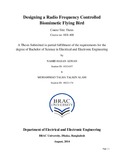| dc.contributor.advisor | Abedin, Amina Hasan | |
| dc.contributor.author | Adnan, Nahid Hasan | |
| dc.contributor.author | Alam, Mohammad Talha Talkin | |
| dc.date.accessioned | 2014-09-14T10:56:48Z | |
| dc.date.available | 2014-09-14T10:56:48Z | |
| dc.date.copyright | 2014 | |
| dc.date.issued | 2014-08 | |
| dc.identifier.other | ID 10321057 | |
| dc.identifier.other | ID 09221174 | |
| dc.identifier.uri | http://hdl.handle.net/10361/3624 | |
| dc.description | This thesis report is submitted in partial fulfillment of the requirements for the degree of Bachelor of Science in Electrical and Electronic Engineering, 2014. | en_US |
| dc.description | Cataloged from PDF version of thesis report. | |
| dc.description | Includes bibliographical references (page 45-46). | |
| dc.description.abstract | The present world has been reached to a stage where most of the sophisticated and sensitive tasks are mostly done by artificial hands. Drones, robots have been replaced the place of human with their uncompromised accuracy and efficiencies. Regards this phenomenon the importance of study about robots or unmanned vehicles to perform sensitive works under human supervision is a high demand of time. We are concentrating on the aerial vehicles; want to integrate our ideas and works to develop a new type of flight system to improve the control and maneuvering abilities of flying UAVs or drones. Our experiments can open a port for next generation flight development for drone applications. Our logic is nothing can fly efficient as the birds do. So copying from the flying behavior of it is possible to gain all the abilities like the bird. We developed a model which flaps its wings in fixed amplitude with variable frequencies. To do this we introduced a crank shaft mechanism to drive the wings. The model is powered by a 100watt dc motor with necessary gearbox assemblies. Making it light weight was always a big challenge from the beginning. With this race we avoided unnecessary decorations in this primary level. The controlling and maneuvering has been done by a radio communication and bird like tail consequently. 3channel radio communication is needed to control the flapping frequency and tail combinations. Flying upward, downward, left, right and 360 degree rolling is possible with this tail combination. We used micro servo motors for tail mechanism. The detailed way the model has been built and the design limitation is illustrated in this thesis. | en_US |
| dc.description.statementofresponsibility | Nahid Hasan Adnan | |
| dc.description.statementofresponsibility | Nahid Hasan Adnan | |
| dc.description.statementofresponsibility | Mohammad Talha Talkin Alam | |
| dc.format.extent | 46 pages | |
| dc.language.iso | en | en_US |
| dc.publisher | BRAC University | en_US |
| dc.rights | BRAC University Internship reports are protected by copyright.
They may be viewed from this source for any purpose,
but reproduction or distribution in any format is prohibited
without written permission. | |
| dc.subject | Electrical and electronic engineering | en_US |
| dc.subject | Radio frequency | en_US |
| dc.title | Designing a radio frequency controlled biomimetic flying bird | en_US |
| dc.type | Thesis | en_US |
| dc.contributor.department | Department of Electrical and Electronic Engineering, BRAC University | |
| dc.description.degree | B. Electrical and Electronic Engineering | |

